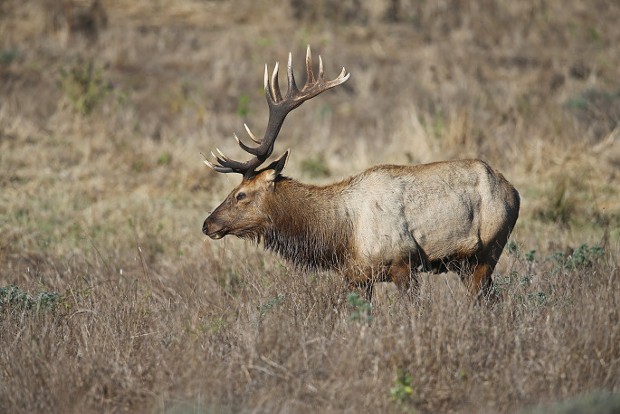Friday, May 8, 2020
Debilitating Hoof Disease Found In Del Norte Elk
Posted By Kimberly Wear @kimberly_wear on Fri, May 8, 2020 at 12:01 PM
What is believed to be the state’s first cases of a debilitating hoof disease has been detected in two Roosevelt elk in Del Norte County, according to the California Department of Fish and Wildlife.
“Treponeme-associated hoof disease (TAHD) – commonly referred to as “elk hoof disease” – can cause deformed, overgrown and otherwise damaged hooves. The lesions and resulting deformities are painful and lead to limping, lameness and even death as observed in other states,” the news release states. “When the disease is severe, elk may become too weak to graze, fight off other infections or escape predators.”
The disease is not known to affect people but hunters are encouraged to “exercise caution and practice safe hygiene when processing, cooking and consuming the meat” if they take an elk with deformed or damaged hoofs and to send a hoof sample to the fish and wildlife.
Believed to be highly contagious among elk, TAHD was first identified in elk from Washington state in the 1990s. There is no known cure or vaccination.
CDFW is working with other agencies and researchers to increase monitoring of the disease in the state, which is home to three subspecies of elk — Rocky Mountain elk, Roosevelt elk and tule elk, the first two of which have been known to contract TAHD.
Fish and wildlife is asking the public to report any elk that appear to be limping, lame or have abnormal hooves by visiting the CDFW’s Wildlife Investigations Lab disease and mortality reporting website, which can be found by clicking here.
Read the full CDFW release below:
“Treponeme-associated hoof disease (TAHD) – commonly referred to as “elk hoof disease” – can cause deformed, overgrown and otherwise damaged hooves. The lesions and resulting deformities are painful and lead to limping, lameness and even death as observed in other states,” the news release states. “When the disease is severe, elk may become too weak to graze, fight off other infections or escape predators.”
The disease is not known to affect people but hunters are encouraged to “exercise caution and practice safe hygiene when processing, cooking and consuming the meat” if they take an elk with deformed or damaged hoofs and to send a hoof sample to the fish and wildlife.
Believed to be highly contagious among elk, TAHD was first identified in elk from Washington state in the 1990s. There is no known cure or vaccination.
CDFW is working with other agencies and researchers to increase monitoring of the disease in the state, which is home to three subspecies of elk — Rocky Mountain elk, Roosevelt elk and tule elk, the first two of which have been known to contract TAHD.
Fish and wildlife is asking the public to report any elk that appear to be limping, lame or have abnormal hooves by visiting the CDFW’s Wildlife Investigations Lab disease and mortality reporting website, which can be found by clicking here.
Read the full CDFW release below:
The California Department of Fish and Wildlife (CDFW) has detected the state’s first cases of a potentially crippling hoof disease in two Roosevelt elk from a resident herd in Del Norte County.
Treponeme-associated hoof disease (TAHD) – commonly referred to as “elk hoof disease” – can cause deformed, overgrown and otherwise damaged hooves. The lesions and resulting deformities are painful and lead to limping, lameness and even death as observed in other states. When the disease is severe, elk may become too weak to graze, fight off other infections or escape predators.
TAHD was first identified in elk from Washington state in the 1990s, but much remains unknown about the disease. Currently, there is no known cure or vaccination. TAHD has been documented in elk in Washington, Oregon and Idaho. Recent detections in Oregon’s Douglas County were previously the closest to California.
TAHD gets its name from a bacterium, Treponema sp., that is associated with this disease, but other pathogens also may play a role. Scientists at Washington State University who are experienced with TAHD confirmed the disease in the two Roosevelt elk from Del Norte County.
It is unknown what impact TAHD may have on elk populations in California or other states. California is home to three subspecies of elk – Rocky Mountain elk, Roosevelt elk and tule elk – that together inhabit approximately 25 percent of the state. In other states, both Rocky Mountain and Roosevelt elk have contracted TAHD.
To date, there are no known cases of TAHD among tule elk. While the disease appears to be highly infectious among elk, there is no evidence that it affects humans. Still, hunters who harvest an elk exhibiting signs of deformed or damaged hooves should exercise caution and practice safe hygiene when processing, cooking and consuming the meat. Hunters also are encouraged to submit hoof samples to CDFW from suspect elk.
CDFW will be working with natural resource agencies in other western states and academic partners to increase surveillance for TAHD in California, plan management actions and facilitate research.
The general public can assist CDFW’s efforts by reporting any elk that appears to be limping, lame or have abnormal hooves via CDFW’s Wildlife Investigations Lab disease and mortality reporting website: https://wildlife.ca.gov/conservation/laboratories/wildlife-investigations/monitoring/mortality-report.
Speaking of...
-

Local Commercial Dungeness Crab Season to Open in January
Dec 20, 2023 -

Local Commercial Crab Season Opener is Set
Dec 22, 2022 -

Commercial Crab Season Delayed
Dec 8, 2022 - More »
Readers also liked…
more from the author
-
Dust to Dust
The green burial movement looks to set down roots in Humboldt County
- Apr 11, 2024
-
Our Last Best Chance
- Apr 11, 2024
-
Judge Rules Arcata Can't Put Earth Flag on Top
- Apr 5, 2024
- More »
































